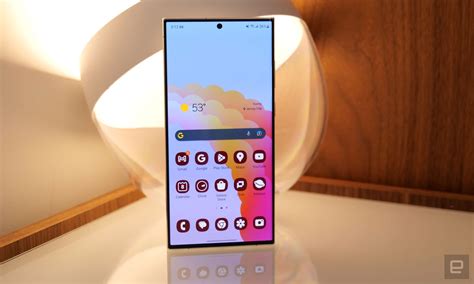Dynamic AMOLED Burn-In: Everything You Need to Know
What is Dynamic AMOLED burn-in?
Dynamic AMOLED burn-in, also known as image retention or ghosting, is a display issue that can occur on OLED (Organic Light-Emitting Diode) screens, including Dynamic AMOLED panels found in Samsung Galaxy devices. It happens when static images are displayed for extended periods, causing those images to become permanently or semi-permanently visible on the screen even when displaying different content.
This phenomenon arises from the way OLED panels work. Each pixel in an OLED screen is made of organic materials that emit light when an electric current passes through them. When a pixel is constantly lit, the organic material degrades faster than the pixels that are frequently turned on and off. This degradation can lead to a noticeable difference in brightness and color between the burnt-in areas and the rest of the screen.
Dynamic AMOLED burn-in is not unique to Samsung Galaxy devices; it can affect any device with an OLED screen, including smartphones, TVs, and even laptops. The severity of the burn-in can vary depending on the specific OLED technology used, the length of exposure to static images, and the brightness of the display.
While burn-in is a potential issue, it’s important to understand that it’s not something that happens easily or quickly. You’re unlikely to experience burn-in if you use your phone normally. However, certain activities can increase the risk, including:
- Playing games with static user interfaces
- Using navigation apps with static elements
- Displaying the same image for extended periods (like a slideshow or wallpaper)
- Having a bright display setting
Fortunately, Dynamic AMOLED screens have built-in features that help to mitigate burn-in risk. These features include:
- Automatic Pixel Shift: This feature subtly shifts the pixels on the screen to prevent any one pixel from being constantly lit. This helps to distribute wear and tear across the display, reducing the risk of burn-in.
- Reduced Brightness: Keeping the brightness levels low can significantly reduce the risk of burn-in. This is because lower brightness means less light is emitted from each pixel, decreasing the strain on the organic materials.
- Screen Timeout: Setting a shorter screen timeout will automatically turn off the screen after a period of inactivity, reducing the risk of burn-in from static images.
By understanding the causes and mitigation techniques, you can enjoy your Dynamic AMOLED display without worrying excessively about burn-in.

Does Dynamic AMOLED burn-in happen on Samsung phones?
While Dynamic AMOLED screens are designed to be resilient against burn-in, it’s still a potential concern. While Dynamic AMOLED is generally considered to be more resistant to burn-in than previous OLED technologies, it’s not entirely immune. Certain scenarios and prolonged exposure to static content can still lead to image retention.
Samsung implements various protective measures in its Dynamic AMOLED displays to mitigate the risk of burn-in. These include features like Automatic Pixel Shift, which constantly shifts pixels on the screen, and Dynamic Contrast Enhancement, which adjusts the brightness and contrast of the display to reduce the strain on individual pixels. However, it’s still advisable to be mindful of using your phone in a way that minimizes the risk of burn-in.
Here are some tips to help prevent burn-in on your Samsung phone:
- Avoid displaying static images on your screen for prolonged periods. This includes images, videos, or even game interfaces with static elements. Consider using a screen timeout to automatically turn off the screen after a period of inactivity.
- Keep the brightness level at a moderate level. While a brighter screen may be more visually appealing, it can accelerate the degradation of the OLED pixels, increasing the risk of burn-in. You can adjust the brightness level in your phone’s settings.
- Enable “Automatic Pixel Shift” in your phone’s settings. This feature subtly shifts the pixels on the screen, distributing the workload across the display and minimizing the strain on any individual pixel. This helps reduce the risk of burn-in.
Remember, Dynamic AMOLED technology is generally very durable, and with a little care and awareness, you can enjoy your Samsung phone’s vibrant display without worrying excessively about burn-in.
Is Dynamic AMOLED screen good for watching videos?
Dynamic AMOLED screens are indeed excellent for watching videos. Samsung’s Dynamic AMOLED technology offers several advantages that make it a great choice for a video-watching experience. Here are some of the key benefits:
- Vibrant colors and deep blacks: Dynamic AMOLED displays use a wide color gamut and offer deep black levels, making colors appear more vivid and realistic. Videos with rich color gradients and dark scenes appear more immersive and visually appealing.
- High refresh rate: Most Dynamic AMOLED displays come with a high refresh rate, usually 90Hz or 120Hz. This means that the screen refreshes more times per second, resulting in smoother and more fluid motion in videos. This is especially noticeable in fast-paced action scenes and high-frame-rate content.
- HDR support: Many Dynamic AMOLED displays support HDR (High Dynamic Range) content, which significantly enhances the viewing experience. HDR allows for a wider range of brightness and contrast, resulting in more detail in bright and dark areas of the video. This makes the overall image look more realistic and immersive.
- Low power consumption: OLED technology, including Dynamic AMOLED, consumes less power than traditional LCD displays, especially when displaying dark content. This means you can enjoy your favorite videos for longer on a single charge.
However, it’s important to note that while Dynamic AMOLED screens are generally excellent for video viewing, the actual experience can vary depending on the specific device and its screen characteristics. Some Dynamic AMOLED screens may have slightly different color calibration or refresh rate capabilities than others. You can adjust the display settings on your device to fine-tune the video experience to your preferences.

Is Dynamic AMOLED burn-in permanent?
Dynamic AMOLED burn-in is not always permanent. In some cases, it can be temporary and may fade over time, especially if the static image is removed from the display. However, in other cases, the burn-in can be more persistent and may not disappear completely.
The degree of permanence of Dynamic AMOLED burn-in depends on several factors, including:
- Duration of exposure to the static image: The longer the static image is displayed, the more likely it is to leave a permanent mark.
- Brightness level: Higher brightness levels increase the likelihood of burn-in, as they put more strain on the OLED pixels.
- OLED technology: Different OLED technologies have varying degrees of susceptibility to burn-in. Dynamic AMOLED is generally considered more resilient than older OLED technologies.
If you notice burn-in on your Dynamic AMOLED screen, there are a few things you can try:
- Remove the static image: If the burn-in is caused by a static image, removing the image from the screen may help reduce its visibility over time.
- Use a burn-in reduction tool: Some apps and software tools claim to help reduce the visibility of burn-in. While their effectiveness can vary, they might offer some relief.
- Contact Samsung support: If the burn-in is severe and doesn’t improve with time, you can contact Samsung support for assistance. Depending on the severity of the issue and the device’s warranty status, they may be able to offer a solution.
It’s important to remember that burn-in is a complex issue, and there is no guaranteed solution. However, by taking preventative measures and seeking appropriate assistance when necessary, you can minimize the risk and impact of burn-in on your Dynamic AMOLED screen.
What are the disadvantages of a Dynamic AMOLED screen?
While Dynamic AMOLED displays offer many advantages, they also come with a few disadvantages. These include:
- Potential for burn-in: As mentioned earlier, Dynamic AMOLED displays are susceptible to burn-in, though the risk is reduced compared to older OLED technologies. Still, it’s important to be aware of this potential issue and take steps to minimize the risk.
- Higher price: Dynamic AMOLED screens are generally more expensive than traditional LCD screens, reflecting the advanced technology used in their production.
- Lower durability: OLED screens are more delicate than LCD screens and can be prone to damage from physical impacts or pressure. This is due to the organic materials used in the construction of OLED pixels.
Despite these disadvantages, Dynamic AMOLED screens offer a compelling combination of features and benefits that make them a popular choice for smartphones and other devices. It’s important to weigh the pros and cons carefully based on your individual needs and preferences before deciding if a Dynamic AMOLED display is right for you.
What is the difference between Dynamic AMOLED and Super AMOLED?
Dynamic AMOLED and Super AMOLED are both types of OLED displays used in Samsung Galaxy devices, but they differ in certain key aspects:
| Feature | Dynamic AMOLED | Super AMOLED |
|---|---|---|
| Color Gamut | Wider color gamut, covering 100% of the DCI-P3 color space | Narrower color gamut |
| Brightness | Generally brighter than Super AMOLED displays, reaching up to 1600 nits peak brightness | Lower peak brightness |
| Refresh Rate | Supports higher refresh rates, often reaching 120Hz or even higher | Typically limited to 60Hz refresh rate |
| Burn-in Resistance | More resistant to burn-in due to improved technology and features like Automatic Pixel Shift | More susceptible to burn-in compared to Dynamic AMOLED |
| Availability | Used in newer Samsung Galaxy devices | Found in older Samsung Galaxy models |
In essence, Dynamic AMOLED represents an advancement over Super AMOLED in terms of color accuracy, brightness, refresh rate, and burn-in resistance. While both display technologies offer a high-quality viewing experience, Dynamic AMOLED provides a more advanced and feature-rich option.
How long does Dynamic AMOLED last?
The lifespan of a Dynamic AMOLED screen is difficult to pinpoint precisely, as it can vary based on factors like usage patterns, brightness settings, and environmental conditions. However, with proper care and usage habits, you can expect your Dynamic AMOLED screen to last for several years without significant degradation.
Here are some tips to prolong the lifespan of your Dynamic AMOLED screen:
- Use a screen protector: A screen protector can help shield your Dynamic AMOLED screen from scratches and other minor damage, prolonging its lifespan.
- Avoid exposing it to extreme temperatures: Extreme heat or cold can damage the organic materials used in OLED panels, so avoid exposing your phone to such environments.
- Keep the brightness level moderate: High brightness levels increase the strain on the OLED pixels, so keeping the brightness at a comfortable level is crucial.
- Use a screen timeout: Setting a screen timeout will automatically turn off the screen after a period of inactivity, reducing the risk of burn-in and prolonging the screen’s lifespan.
By following these tips, you can significantly extend the lifespan of your Dynamic AMOLED screen and continue to enjoy its vibrant colors and immersive viewing experience for years to come.
Is Dynamic AMOLED better than OLED?
Dynamic AMOLED is a type of OLED display, so it’s not necessarily “better” than OLED in general. Instead, it’s an advancement and improvement upon traditional OLED technology. Dynamic AMOLED offers several enhancements, including:
- Wider color gamut: Dynamic AMOLED displays cover a wider range of colors, offering more vibrant and realistic images compared to older OLED technologies.
- Higher brightness: Dynamic AMOLED screens can achieve higher peak brightness levels, improving visibility in bright environments.
- Improved burn-in resistance: Dynamic AMOLED incorporates advanced features like Automatic Pixel Shift to minimize the risk of burn-in, making it more resilient to image retention than older OLED technologies.
Therefore, while Dynamic AMOLED is a type of OLED, it’s considered an improved and more advanced version with enhanced features and capabilities. This makes Dynamic AMOLED a superior choice for devices that prioritize color accuracy, brightness, and burn-in resistance.
Can Dynamic AMOLED burn-in be fixed?
While Dynamic AMOLED burn-in is not always permanent, it can be challenging to completely fix. However, there are a few things you can try:
- Remove the static image: If the burn-in is caused by a static image, removing the image from the screen may help reduce its visibility over time. This is especially true for temporary burn-in.
- Use a burn-in reduction tool: Some apps and software tools claim to help reduce the visibility of burn-in. These tools often utilize techniques like color shifting, brightness adjustment, or pixel manipulation to attempt to mask the burn-in. While the effectiveness of these tools can vary, they might offer some relief.
- Contact Samsung support: If the burn-in is severe and doesn’t improve with time, you can contact Samsung support for assistance. Depending on the severity of the issue and the device’s warranty status, they may be able to offer a solution or replacement.
It’s important to remember that burn-in is a complex issue, and there is no guaranteed solution. However, by taking preventative measures and seeking appropriate assistance when necessary, you can minimize the risk and impact of burn-in on your Dynamic AMOLED screen.
FAQ
Does screen protector help with Dynamic AMOLED burn-in?
A screen protector won’t directly prevent burn-in on a Dynamic AMOLED display. Burn-in is a phenomenon that occurs within the OLED panel itself, not on the surface of the screen. While a screen protector can protect the display from scratches and other physical damage, it doesn’t influence the underlying OLED technology that can lead to burn-in.
Is Dynamic AMOLED better than LCD for gaming?
Dynamic AMOLED displays offer several advantages for gaming, including vivid colors, deep blacks, high refresh rates, and faster response times. However, the best choice between Dynamic AMOLED and LCD for gaming ultimately depends on individual preferences and priorities.
Dynamic AMOLED screens excel in areas like image quality, immersion, and smoothness of gameplay, especially for games with rich graphics and fast-paced action. On the other hand, LCD screens often offer higher peak brightness, which can be advantageous for outdoor gaming or in brightly lit environments. Ultimately, the best option for you depends on your individual gaming needs and priorities.
Does Dynamic AMOLED screen cause eye strain?
While Dynamic AMOLED screens are generally considered to be comfortable for viewing, some users may experience eye strain, especially during prolonged use. This can be due to factors like blue light emissions, screen brightness, and individual sensitivities.
To minimize eye strain, you can adjust the display settings on your phone, such as reducing the brightness level, enabling a blue light filter, and setting a shorter screen timeout. You can also take breaks from screen time and engage in other activities to prevent eye fatigue.
Is Dynamic AMOLED good for reading?
Dynamic AMOLED displays can be good for reading, as they offer excellent contrast and color accuracy, making text appear sharp and clear. However, some users may find the high contrast and vibrant colors to be a bit harsh for long reading sessions.
To make reading more comfortable on a Dynamic AMOLED screen, you can adjust the display settings, such as enabling a reading mode or night mode. These modes often reduce the screen’s blue light emissions and adjust the contrast and brightness for a more comfortable reading experience.
Is Dynamic AMOLED good for drawing?
Dynamic AMOLED screens are often praised for their color accuracy, responsiveness, and high refresh rates, making them a good option for drawing on a digital canvas. The vibrant colors and excellent contrast can enhance the artistic experience, while the smooth responsiveness ensures precise and fluid strokes.
Does Dynamic AMOLED have better color accuracy than LCD?
Dynamic AMOLED screens typically offer better color accuracy than traditional LCD screens, especially when it comes to displaying a wider range of colors and achieving deeper black levels. This is due to the nature of OLED technology, where each pixel can be independently controlled and turned off completely for true black levels.
While some high-end LCD screens have made strides in color accuracy, Dynamic AMOLED screens generally excel in this regard. They are well-suited for tasks like photo editing and video viewing, where accurate color reproduction is essential.
Can I disable Dynamic AMOLED?
You cannot disable Dynamic AMOLED as it is a core technology within the display panel itself. It’s not a separate software setting that can be turned off. Dynamic AMOLED is integrated into the hardware of the display and is responsible for the screen’s overall performance and visual characteristics.



